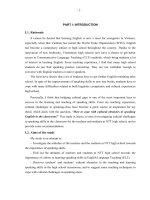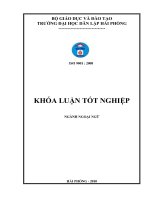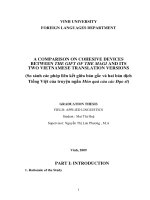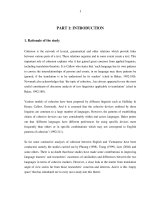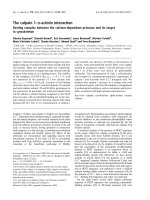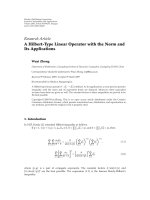A comparison on cohesive devices between the gift of the magi and its two vietnamese translation versions
Bạn đang xem bản rút gọn của tài liệu. Xem và tải ngay bản đầy đủ của tài liệu tại đây (289.34 KB, 61 trang )
Vinh university
Foreign languages department
A comparison on cohesive devices
between the gift of the magi and its
two Vietnamese translation versions
(So sánh các phép liên kết giữa bản gốc và hai bản dịch
Tiếng Việt của truyện ngắn Món quà của các Đạo sĩ)
Graduation thesis
Field: applied Linguistics
Student : Mai Thị Huệ
Supervisor: Nguyễn Thị Lan Phương , M.A
Vinh, 2009
Part I: introduction
1. Rationale of the Study
1
Vietnam is more and more integrating deeply into the world in many
fields, of which there is literature. As a matter of fact, once foreign
literature is more available in the market, Vietnamese reader’s tastes for
literature are also changing – they are becoming more interested in foreign
works. Even with those who do not speak foreign language, the enjoying of
foreign literature is still made possible thanks to translators. It can be said
that translated literature has become an important part in Vietnam literature
nowadays. This, naturally, leads to the fact that there are different
translated versions for the same foreign work, and, accordingly, there exists
a comparison between them. However, to non-linguistic people, it is
difficult to exactly tell why they prefer this than the other, they might just
instinctively feel the difference. Deriving from this, many studies have
been done on different aspects in order to find out the reasons for success
of this translation and the failure of the other.
There have been some works that analysed and contrasted cohesion
between English and Vietnamese so far. The purpose of these works is to
point out the similarities and differences between the two languages in
terms of cohesive devices. This research is, by no means, an exception.
Having read one typical short-story by O.Henry, The Gift of The Magi, and
two translated versions, the author has been attracted with the idea of
comparing two translated versions on textual equivalence.
According to Callow (1992) each language has its own pattern to
convey the interrelationships of persons and events; in no language may
these patterns be ignored, if the translation is to be understood by its
readers. This is the reason why cohesion gained a great deal of concern
from applied linguists.
2
Among many linguists, Halliday and Hasan (1976) make a detailed
classification of cohesive devices in English. These authors distinguish
between grammatical and lexical cohesion. It is obvious that those outlined
devices are common to almost language. Baker states that different
languages have different preferences for using specific devices more
frequently than others or in specific combination which may not
correspond to English pattern of cohesion (1992, p.219)
O. Henry was a prolific American short-story writer, a master of
surprise endings, who wrote about the life of ordinary people in New York
City. A twist of plot, which turns on an ironic or coincidental circumstance,
is typical of O. Henry’s stories. This is also the reason why he got the love
from lots of Vietnamese readers. Apart from The Last Leaf, the readers
have known The Gift of the Magi as a typical short- story by O. Henry. It is
translated into Vietnamese by many translators and each Vietnamese
translation version has an interesting characteristic, giving the researcher a
desire to conduct this study. This study focuses on textual equivalence
between the source and two target language texts. One is translated by Dac
Le in the “Love of life” book that includes The selected American short
stories by The World Publisher, Ha Noi, 1994. The other is from the O.
Henry short stories by Ngo Vinh Vien, that has been republished many
times. This paper chooses the translation version in 2005 in the same book
by Literature Publisher, Hanoi.
2. Aims of the Study
The aims of the thesis are:
- To provide an overview of cohesive devices
- To study cohesion in translation in a particular text type
3
- To identify the cohesive markers in The Gift of the Magi and its
translation versions.
- To study the textual equivalence between the original work and its
Vietnamese translations.
- To suggest some implications for teaching and learning translation in
general and teaching and learning cohesion in particular.
3. Scope of the study
The study focuses on the textual equivalence between The Gift of the
Magi by O. Henry and its two translation versions. More detailedly, the
study focuses on cohesion only. Themantic and information structures,
another important aspect of textual equivalence will not be covered in the
scope of the study. The ground for doing this research is the system of
cohesive markers suggested by Halliday and Hasan (1976) and Diep Quang
Ban (2005) and the definition equivalence proposed by Baker (1992).
4. Research Questions
To achieve the purposes of the study, some research questions will be
adhered.
- Is the model of cohesion proposed by Halliday and Hasan common
to Ban’s?
- What kind of cohesive markers are preferred in The Gift of the Magi
and by the translators in Vietnamese translation? Which one is the most
popular in each translation?
- Which is more popular, the translation version by Dac Le or the one
by Ngo Vinh Vien?
5. Methods of the Study
4
- The study is carried out using the quantitative method with
collecting, analyzing and clarifying the procedure of collecting data in
order to answer the research questions.
- Review of the theories related to cohesion and translation
- Analysis and synthesis of the collected data.
6. Design of the Study
The thesis consists of three parts:
Part I: Introduction states the reasons for choosing the topic, the
aim, its scope, the research question and method of the study.
Part II: Development consists of 3 chapters:
Chapter 1: Theoretical background states the theoretical background
of cohesion, cohesion and coherence, type of cohesion, translation theory,
O.Henry and The Gift of The Magi.
Chapter 2: Identification of cohesive markers in the original text,
such as reference, substitution, ellipsis, conjunction, lexical cohesion and
the summary in general.
Chapter 3: Handling of cohesive markers in the Vietnamese
translations conclude handling of reference, substitution, ellipsis,
conjunction, and handling of lexical cohesion and general remarks.
Part III: Conclusion summarizes the main points of the thesis, states
the application and presents including remarks.
Part II: development
5
Chapter 1: Theoretical background
1.1.
Some Related Concepts of Discourse Analysis
1.1.1. Cohesion
A text, generally speaking, can be recognized as a sentence or a
group of sentences because of its clear relationship of ideas. Yet, how to
identify what makes a text coherent? What makes a cohesive grammatical
unit different from a random collection of sentences? Halliday and Hasan
(1976) pointed out by defining text as “… not just a string of sentences. It
is not simply a large grammatical unit, something of the same kind as a
sentence; but differing from it in size – a sort of supersentence a semantic
unit” (p.291). Because it is a semantic unit, the state of being a text (its
texture) is dictated by its interpretation within a particular context, or
environment. Let’s see this example:
[1:1]
Woodrow Wilson was twenty-fifth President of the United
States. He will be always remembered for his work to establish world
peace.
(The History of The US in brief)
This text is coherent because He in the second sentence refers back to
Woodrow Wilson in the first one. In fact, the second sentence without its
contextual reference would not make much sense.
The concept of cohesion is a semantic one, it refers to relations of
meaning that exist within the text and that define it as a text. “Cohesion
occurs where the interpretation of some elements in the discourse is
dependent on that of another. The one presupposes the other, in the sense
that it can not be effectively decoded except by recourse to it. When it
happens, a relation of cohesion is set up, and the two elements, the
6
presupposing and the presupposed, are thereby at least potentially
integrated into a text. (Halliday and Hasan ,1976, p.4)
Returning to the example, the word He in the second sentence creates
the cohesion by itself in the text and the two sentences combine together,
leading to unity.
It seems that Halliday and Hasan’s idea has similarity with Diep
Quang Ban’s. Ban in Ngữ PhápTiếng Việt (2005) states that cohesion is in
the links between two semantic elements which lies in two sentences or in
two clauses of a sentence. Therefore, they explain to each other. In other
words, cohesion is the semantic relation in which to understand the specific
meaning of this element, we must base on the meaning of the other.
[1: 2]
Bản tuyên ngôn nhân quyền và dân quyền của Cách Mạng
Pháp năm 1791 cũng nói: “Người ta sinh ra tự do và bình đẳng về quyền lợi
và phải ln ln được tự do và bình đẳng về quyền lợi”. Đó là những lẽ
phải khơng ai chối cãi được.
(Tun ngơn độc lập, Hồ Chí Minh)
The readers do not make sense Đó in the second sentence if they do
not base on the meaning of the first sentence. In other words, the second
shares the link with the first to be made sense.Similarly to viễn cảnh ấy in
the following example:
[1: 3]
Tới đây ta mới hiểu thế nào là sự sợ hãi khi phải vĩnh viễn
xa P. Đừng, lạy chúa, viễn cảnh ấy đừng bao giờ xảy ra cả, đừng, mà ta
sống với ai, sống trơ trọi và cô đơn thế, ta làm sao sống nổi.
(Mãi mãi tuổi hai mươi, Nguyễn Văn Thạc)
7
Another example:
[1: 4]
Ơng sống một thân, một mình. Ơng tứ cố vơ thân.
(Thầy Khiển, Ma Văn Kháng)
Một thân một mình in the first sentence and tứ cố vô thân in the
second one are synonymous because they explain meaning to each other.
[1: 5]
Đồi bạch đàn vẫn thong thả đồng ca bài hát cổ xưa của
mình. Bạch đàn ơi, bỡ ngỡ gì mà em xòe lá? Hương bạch đàn, nhựa bạch
đàn gợi điều gì mơ mộng quá … Em ở đâu chẳng về anh dắt tay em…
(Mãi mãi tuổi hai mươi, Nguyễn Văn Thạc)
Bạch đàn in the second sentence is repeated in the second one,
creating lexical cohesion in the text.
Halliday and Hasan (1976) make a detailed classification of the
cohesive devices in English. These authors as well as Ban (2005)
distinguish between grammatical and lexical cohesion. According to them,
grammatical cohesion embraces four different devices: Reference,
substitution, ellipsis, and conjunction and lexical cohesion consists of
repetition,
synonymy,
superordinate,
hyponymy,
metonymy
and
antonym…
1.1.2. Cohesion and Coherence
According to Lam (2007) in the Discourse analysis, Cohesion is a
guide to coherence, and coherence is something created by the reader in the
act of reading the text. Coherence is the feeling that a text hangs together,
that it makes sense, and is not just a jumble of sentences.
Coherence relations are meaning relations connecting two text
segments. A defining characteristic for these relations is that the
interpretation of the related segments needs to provide more information
8
than is provided by the sum of the segments taken in isolation. Hoey points
out the differences between cohesion and coherence as follows: “Cohesion
is the objective capable in principle automatic recognition, while
coherence is subjective and judments concerning it may vary from readers
to readers” (cited in Baker, 1992, p.218). In other words, cohesion is only
the clues to coherence, consisting of grammatical and lexical links in the
text while coherence is in the reader’s mind and they have to create
coherence by themselves. Let’s consider the example:
[1: 6]
Clare loves potatoes. She was born in Ireland
(Discourse analysis)
These sentences are cohesive because she in the second sentence
refers back to Clare in the first sentence. This anaphoric function of she
gives cohesion to the two sentences. However, the two sentences are only
coherent if the readers know stereotype ethnic association between being
Irish and loving potatoes.
It is clear that cohesion approach to connectedness is inadequate.
According to Nguyen Hoa (2002) cohesion can be understood as means to
indicate coherence but it is completedly wrong when whoever considers
they are one. Between them, there is not exists a one-to-one
correspondence. In the example:
[1: 7] A: My car’s broken down
B: There’s a garage down there.
The readers do not see any cohesive devices in the example but they
still get the meaning of sentences thanks to its coherence.
1.1.3. Type of Cohesion
Halliday and Hasan (1976) identified five different types of cohesion:
reference, substitusion, ellipsis, conjunction, and lexical cohesion.
9
1.1.3.1. Reference
Reference is an act in which a speaker or a writer uses linguistic forms
to enable a listener, or reader, to identify something. It refers to the
semantic relationship between a word and what it points to in the real
world. Let’s see the category of reference.
Reference
Exophora
Endophora
(situational)
(textual)
Anaphora
(to preceding text)
Cataphora
(to following text)
Exophora or exophoric reference is reference to be assumed, shared
words outside of the text. Because it is not text- internal, it is not truly
cohesive, but because it is an equally important part of the readers’ active
role in creating coherence, contributing to “textuality”, that is, the feeling
that something is in the text, and not just a random collection of sentences.
Endophora or endophoric reference comes into being when an
identified element is understood by means of identified element in another
sentence. Consequently, cohesion is created between two sentences. In the
following example:
[1:8]
Robin was really a hero rather than a criminal. He robbed the
rich and gave to the poor.
(English Pronunciation Made Simple)
10
Robin is a concrete linguistic element, implying a name of a man. He
in the second sentence is understood as an identified element. Thanks to
this element, two sentences stick together.
Halliday and Hasan (1976) outlined three sub-types of referential
cohesion: personal, demonstrative and comparative.
a. Personal Reference
Personal reference can be seen as a function in the speech situation. It
is expressed through pronouns and determiners. They serves to identify
individuals and objects that are named at some other point in the text. Here
are the category of person by Halliday and Hasan (1976).
Other roles
Speech roles
Speaker
addressee
Specific
Human
One
More than
one
I
me
my mine
We
us
You you
your yours
ours our
He
his
him
his
She her
hers her
They
theirs
Non human
It
[its]
its
its
Them
Their
One one
one’s
(Halliday and Hasan, 1976, p.44)
The category points out all the personal references in details.
Halliday states that personals referring to the speech roles (speaker and
addressee) are typically exophoric (situational), including I and you, and
we mean you and I. In fact, they sometimes become anaphoric, specially in
written languages such as narrative fiction. Let’s see example:
11
[1:9] My rich dad, on the other hand, always referred to himself as rich.
He would say things like, “I am a rich man, and rich people don’t do this”
I in the second sentence refers back to “My rich dad” in the first
sentence and He in the second sentence.
From the category above, we see that the third person forms She, He,
It, They can be anaphoric.
However, there are varieties of personal in Vietnamese. Ban (2001)
indicated the personal references in the table follow:
Pronounce
The 1st
(speaker)
Tơi, tao ,
tớ, mình, ta
Chúng
tơi, chúng tao,
chúng tớ,
chúng mình,
chúng ta.
Meaning of
The 2nd
(listener)
The 3rd
(person or object
is referred)
Mày, mi
Nó, hắn, y,
thị,
Chúng mày,
chúng bay, bọn
bay.
Chúng,
chúng nó, bọn
nó, bọn chúng
nó, bọn hắn.
speech
situation
Singular
form
Plural form
Examples:
[1:11] Đó là, không trông thấy tôi nhưng chị Cốc đã trông
thấy Dế Choắt đang loay hoay trong cửa hang, chị Cốc liền qt lớn:
- Mày nói gì?
- Lạy chị, em nói gì đâu?
(Dế mèn phiêu lưu kí, Tơ Hồi)
In the example, Mày in the second sentence and em in the third one
refer back to Dế Choắt.
Ban states that personal references in Vietnamese includes kinship
noun and social position word, mostly the first and the second personal in
12
respective. To translate exactly meaning of personal references from
English to Vietnamese requires a deep knowledge of personal references in
Vietnamese.
Example:
[1:12]
Tôi hỏi:
- Anh ơi! Anh ốm thế nào mà còm nhỏm như vậy?
Anh nhăn mặt:
- Chú nói be bé chứ khơng có anh váng cả đầu. Không, anh không ốm,
tạng người anh nó thế.
(Dế mèn phiêu lưu kí, Tơ Hồi)
b. Demonstrative Reference
Demonstrative reference keeps track of information through location
using proximity reference, expressed through determiners and adverbs.
Halliday outlined the system of demonstrative reference as follows:
Neutral
the
near
near
far
singular
selective
this
far
that
participation
plural
place
these
those
here
there
circumstance
time
now
(Halliday and Hasan, 1976, p.57)
13
then
These items in the system are all demonstrative reference. They can
present a singer word or phrase, or much longer chucks of text – ranging
across several paragraphs or even several pages.
[1:13]
Recognizing that his country had to change, Gowbachey
could have become a cautious modernizer in the Chinese fashion,
promoting economic reform and sponsoring new technology while holding
firm against political change. This did not happen.
(Discourse analysis)
[1:14]
He felt defeated and disheartened, a sad, inept creature,
doomed to a miserable life with no possibility for tomorrow, and that, quite
simply, was that.
This and that in these examples above refer anaphorically to an
extended passage of text.
However, there is a difference in terms of demonstrative compared
with that in Vietnamese. In Vietnamese, demonstrative seems to be more
limited than that in English because demonstrative reference is the order of
words like: này, kia, ấy, nọ after nouns in earlier sentence.
Example: Bà ấy, anh kia, cái bàn này, cái đó, con ấy, …
[1:15] Khơng viết nổi P. ạ, khơng sao viết nổi, vì nỡi thương cảm sâu
xa bóp nghẹt trái tim T. Khn mặt dịu dàng ấy sao hôm nay im lặng thế,
xôn xao lòng ta, là vần thơ của nhà thơ nào, lâu lắm không nhớ rõ, cứ lan
lan…
(Mãi mãi tuổi hai mươi, Nguyễn Văn Thạc)
Khuôn mặt dịu dàng ấy in the second sentence is non-definite,
causing ambiguity but its meaning depends on the preceding sentence,
refers back to “P” and cohesion is established.
14
c. Comparative Reference
Comparative reference keeps track of identity and similarity through
indirect references. It serves to compare items within a text with some
words such as: same, equal, identical(ly), similar, such, so, likewise,
similarly, more, fewer, etc.
Example:
[1: 16]
She is more beautiful girl than I am
Comparative reference is also used cataphorically. Reference points
for more beautiful which lies in the following sentence.
The expressions such as same, equal, identically, similar, such, so,
likewise, similarly, more, fewer, etc… are serves to compare items within a
text.
[1:17] Have another coffee?
[1:18] And such a shame that, back then, the Guiness Book of World
Records people weren’t around to document the third day when, without a
single rest, he whipped out another daily distance record by mid- afternoon.
1.1.3.2. Substitution
According to Halliday and Hasan substitution is the placement of one
item by another, creating the link between sentences.
[1:19] The Lion was about to reply when suddenly they came to
another gulf across the road. But this one was so broad and deep that the
Lion knew at once he could not leap across it.
In the example one substitutes for gulf.
There are three types of substitutions in English: nominal, verbal and
clausal.
a. Nominal substitution
15
[1:20]
I had two fathers, a rich one and a poor one.
b. Verbal substitution
[1:21]
A: Did Mary take that letter?
B: She might have done.
(Discourse analysis)
c. Clausal substitution
[1:22]
A: Does Susan love Peter?
B: I think so.
In each example above, one, do, so replace respectively part of the
preceding text. However, these words can only be interpreted in relation to
what has gone before.
1.1.3.3. Ellipsis
Ellipsis is the omission of an item, that is, one of the identical
linguistic elements is omitted. In fact, ellipsis is described as a form of
substitution in which the original item is replaced by zero. The structure
has a “missing” element which, however, is supplied by the context.
[1:23] The children will bring the small boxes, the adults the large
ones.
Although this example occurs ellipsis in term of verbal, the readers get
the full meaning supplied by the context.
In English, there have three types of ellipsis: norminal, verbal and
clausal.
Ellipsis can be marked by (0).
a. Norminal ellipsis
[1:24] My kids play an awful lot of sport. Both (0) are incredibly
energetic.
(Discourse analysis)
16
[1:25] The problem was, the rich man was not rich yet and the poor
man not yet poor. Both (0) were just starting out on their careers, and both
were struggling with money and families.
(Rich dad, poor dad, Robert T. Kiyosaki)
Men here has been omitted. However, the readers can catch the
meaning by refering back to the first sentence. Then cohesion occurs.
b. Verbal ellipsis
[1:26]
A: Will anyone be waiting?
B: Jim will (0), I should think.
c. Clausal ellipsis
[1:27]
A: Why’d you only set three places? Paul’s staying for a
dinner, isn’t he?
B: Is he? He didn’t tell me (0).
[1:28]
A: Could I have a seat?
B: Yes.(0)
1.1.3.4. Conjunction
The last of these relationships, conjunction, as described by Bloor
and Bloor (1995: 98) acts as a “cohesive tie between clauses or sections of
text in such a way as to demonstrative a meaningful pattern between them”.
However, Halliday and Hasan (1976, p.227) indicate that conjunctive
relations are not tied to any particular sequence in the expression. It
functions somewhat differently than the other relationships because it is not
strictly semantic or anaphoric rather, it is related to the entire environment
of sentences together. There are several kinds of conjunction: single-word
conjunction, phrasal and clausal ones. For example:
[1:29] There were no children there, and it was right time, but he
addressed all who might be dreaming of the Neverland and who were
therefore nearer to him than you think.
17
and originates an additive conjunctive relation, creating cohesion in
the text.
Additive conjunctions act to structurally coordinate or link by
adding to the presupposed item and it is signaled through “and, also, too,
furthermore, additionally…
Additive conjunction may also act to negate the presupposed item and
is signaled by “nor, and … not, either, neither”
[1:30] From a marketing viewpoint, the popular tabloid encourages
the reader to read the whole page instead of choosing stories. And isn’t that
what any publisher wants?
Adversative conjunctions act to indicate “contrary to expectation”
(Halliday and Hasan, 1976, p. 250) and are signaled by: yet, though, only,
but, in fact, rather, etc.
[1:31] I’m afraid I’ll be home late tonight. However, I won’t have to
go in until late tomorrow.
Causal conjunctions express “result, reason and purpose” and are
signaled by “so, then, for, because, for this reason, as a result, in this
aspect.etc.
[1:32] Chinese tea is becoming increasingly popular in restaurants,
and even in coffee shops. This is because of the growing belief that it has
several health- giving properties.
Temporal conjunctions exist when the events in a text are related in
terms of the timing of their occurrence, that is, a link by signaling sequence
in time. Some temporal conjunctive signals are: then, next, after that, next
day, until then, at the same time, at this point,etc.
[1:33] President Roosevelt reacted to Japan’s invasion of Indochina
by taking three major steps. First, he took control of all Japanese money in
18
the United States. Second, he brought the armed forces of the Philippines
under American command. And third, he closed the Panama Canal to
Japanese shipping.
(The History of The US in brief)
1.1.3.5. Lexical Cohesion
Lexical cohesion differs from the other cohesive elements in text in
that it is non-grammatical. Halliday and Hasan (1976, p.274) states that
lexical cohesion to the “cohesive effect achieved by the selection of
vocabulary”
The two basic categories of lexical cohesion are reiteration and
collocation.
a. Reiteration
Reiteration relates to the repetition of a lexical item, either directly or
through the use of a synonym, a superordinate or a generally related word.
The repetition of lexical items is described as the most direct form of
lexical cohesion.
[1:34]
In a little district west of Washington Square the streets
have run crazy and broken themselves into a small strips called “places”.
These “places” make strange angles and curves.
(The Last Leaf, O. Henry)
However, the repetition of lexical items doesn’t need to be in the same
morphological shape. For example “hunting” and “hunted” in the following
sentences:
[1:35] Britain’s green and pleasant meadows yesterday became
“killing field” with the start of the fox cub hunting season. More than 6,000
19
young foxes enjoying the first flush of life will be hunted down in the next
three months to give experienced young hounds a blood lust.
(from News on Sunday, 2 August 1987, p.10 )
b. Synonymy
The lexical relations are established by using the words denoting the
same meaning. For example, in:
[1:36] In Mexico, Edward Weston started to sharpen the “ straight
photography” way of taking pictures that he had begun to develop before
his trip to New York. He took pictures of people he met and of objects and
buildings. His pictures appeared to represent the true of his subjects. He
also took many photographs of cultural objects called folk art.”
(English Pronunciation Made Simple)
Started is synonymous with begun, pictures with photographs,
creating cohesion in the text without any cohesive devices.
However, when we speak of synonym, then, we mean varying degrees
of “loose” synonymy, where we identify not only a significant overlap in
meaning between two words but also some contexts where they can not
substitute for each other.
c. Collocation
Collocation pertains to lexical items that are likely to be found
together within the same text. Collocation occurs when a pair of words is
not necessarily dependent upon the same semantic relationship but rather
they tend to occur within the same lexical environment (Halliday and
Hasan, 1976, p. 286). The closer lexical items are to each other between
sentences, the stronger the cohesive effect.
1.2. Translation Theory
20
